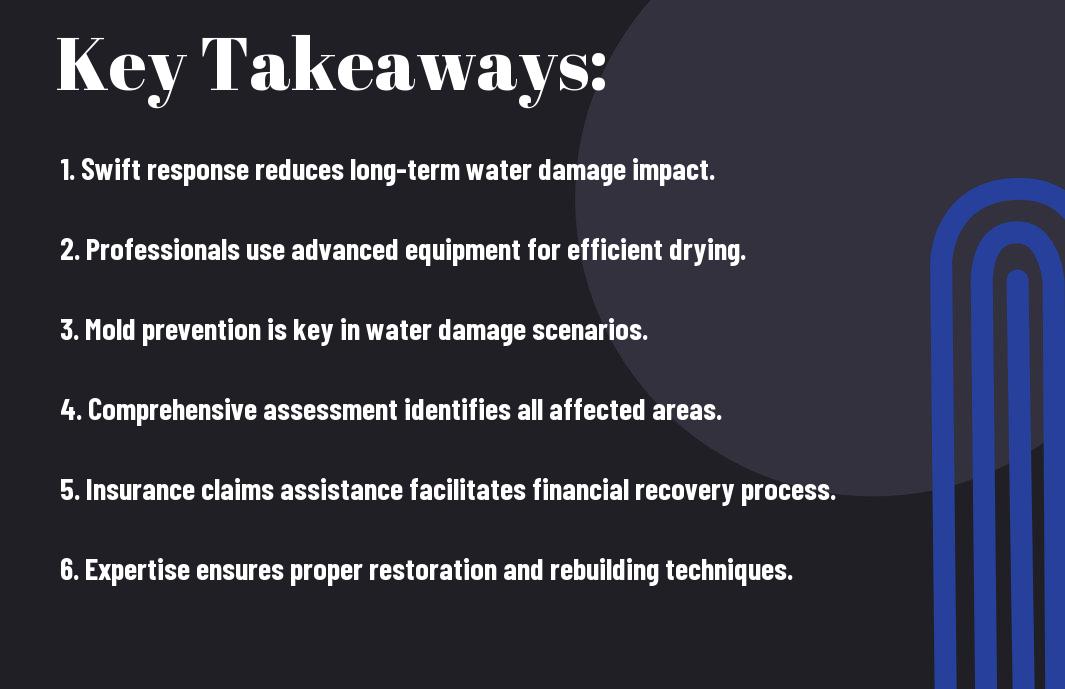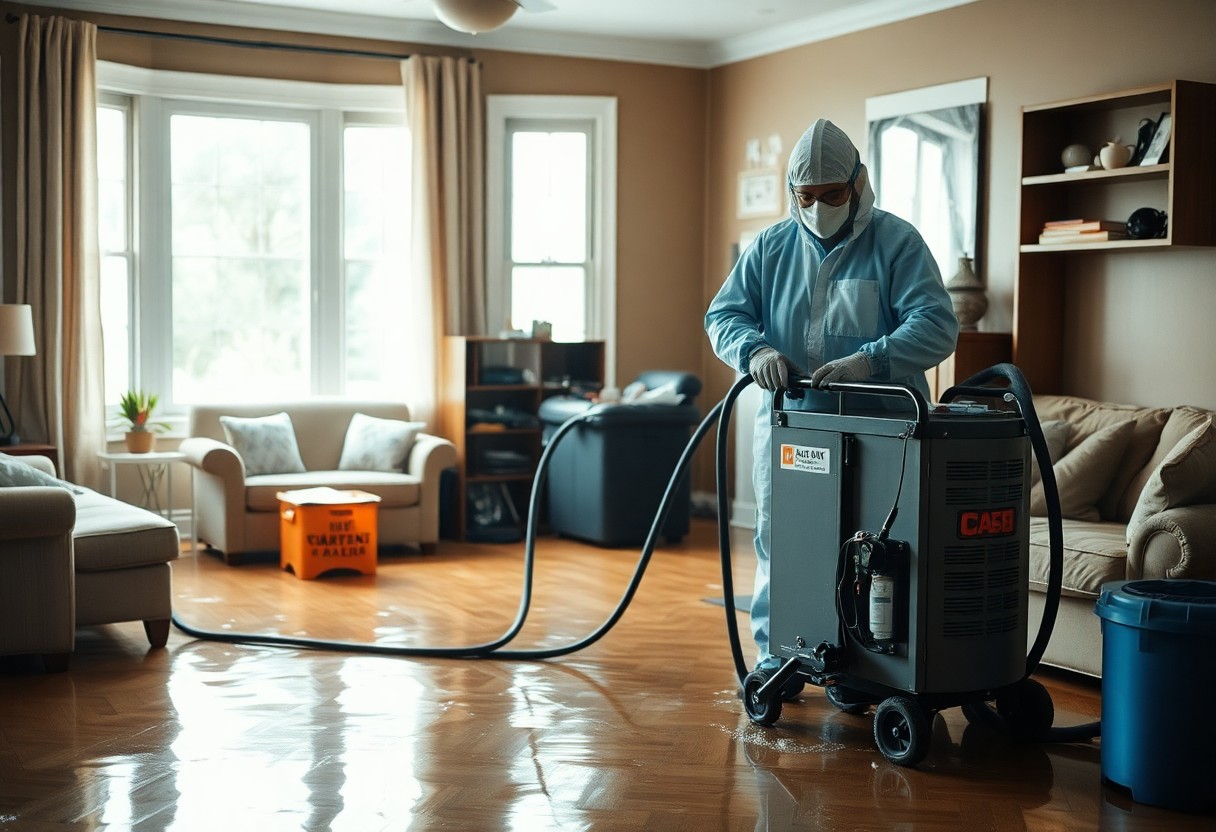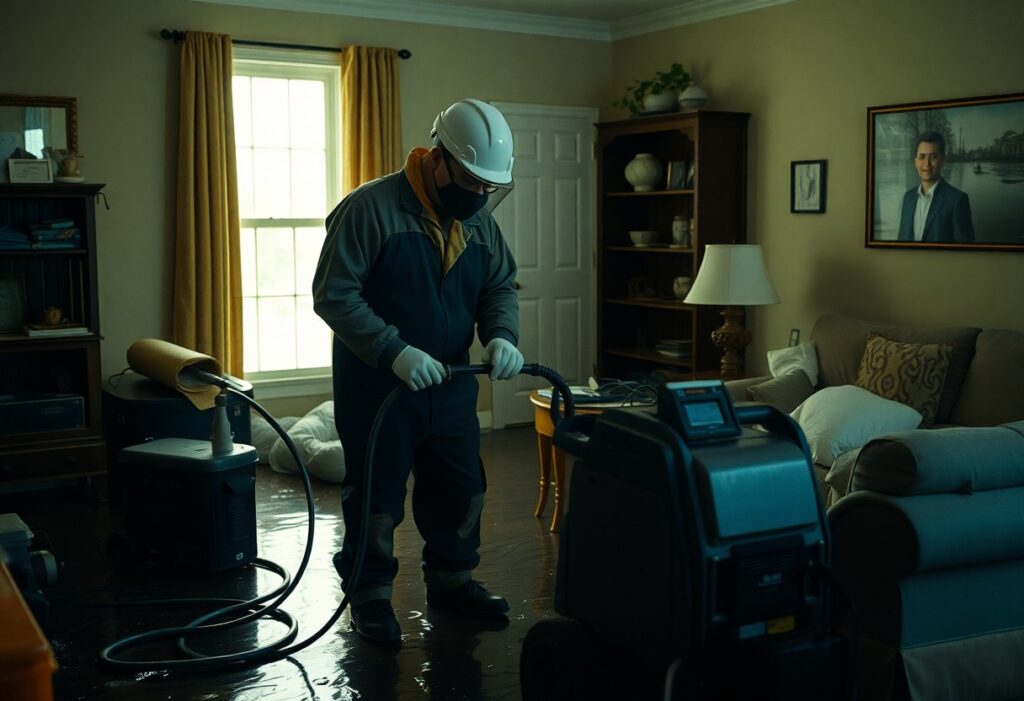Mitigation of water damage is important to protect your home and belongings from the devastating effects of floods or leaks. Service Pro Restoration water mitigation specialists can significantly reduce the impact on your property, ensuring timely extraction of water and preventing mold growth. These experts not only address immediate challenges but also create a comprehensive plan to restore your home to its pre-damage condition. By trusting professionals, you can have peace of mind knowing that your property is in capable hands, allowing you to focus on what truly matters during such stressful times.
Key Takeaways:
- Expertise: Water mitigation specialists are trained professionals who use specialized knowledge and equipment to assess and manage water damage effectively.
- Prompt Response: Timely intervention by these specialists can significantly reduce the extent of water damage and minimize associated recovery costs.
- Comprehensive Services: They provide a range of services, including water extraction, drying, dehumidification, and mold prevention to ensure thorough restoration.
What Are Water Mitigation Specialists?
The water mitigation specialists are experts who focus on minimizing the damage caused by water intrusions, such as leaks, floods, or burst pipes. Their primary goal is to prevent further deterioration of your property while ensuring a safe and healthy environment for you and your family. These professionals utilize specialized equipment and techniques to effectively remove water, dry out affected areas, and restore your space to its former condition.
Who They Are and What They Do
Mitigation specialists come equipped with the knowledge and tools necessary to tackle water-related issues in your home or business. They conduct thorough inspections to locate sources of moisture and assess the extent of the damage. Once identified, they utilize advanced technologies like water extraction pumps and industrial-grade dehumidifiers to eliminate water and prevent mold growth, ensuring a swift recovery.
Importance of Their Role
After water damage occurs, it is crucial to act quickly to prevent complications such as mold infestations and structural issues. Water mitigation specialists play a pivotal role in this process, as their expertise allows them to efficiently address the situation before it worsens. They provide not only restoration services but also guidance on preventing future incidents.
And by engaging a water mitigation specialist, you safeguard your property and your health. Their prompt response minimizes the potential for long-term damage and the risk of mold growth, which can lead to serious health issues. Moreover, they help reduce the financial burden of repairs, saving you time and stress in the long run. Ultimately, their skillful intervention ensures that you can return to your normal routine as quickly and safely as possible.

Signs You Need a Water Mitigation Specialist
Assuming you’re noticing any signs of water damage in your home, it’s crucial to act promptly. Water-related issues can escalate quickly, causing further damage to your property and posing health risks. If you see irregular stains on walls or ceilings, experience damp odors, or notice pooling water, it may be time to consult with a water mitigation specialist to address the problem effectively.
Common Indicators of Water Damage
By keeping an eye out for common indicators, you can better protect your home. Look for discoloration on surfaces, mold growth, or increased humidity levels in your living space. These signs often point to hidden leaks or flooding, which can lead to severe damage if neglected.
When to Call for Help
Mitigation is necessary if you suspect significant water damage or your home has experienced flooding. Take action immediately if you see large amounts of water, or if you notice persistent odors or mold. By doing so, you can minimize damage, mitigate health issues, and potentially save on costly repairs down the line.
Considering the potential risks of water damage, you should never hesitate to call a professional if the situation seems out of control. Persistent leaks or major flooding can compromise your home’s structural integrity and lead to mold growth, which poses serious health risks. It’s always better to seek help sooner rather than later, ensuring your property stays safe and sound.
The Water Mitigation Process
Many homeowners find themselves overwhelmed after experiencing water damage, but understanding the water mitigation process can bring some peace of mind. This process involves a series of steps that help minimize damage, including assessment, water removal, drying, and ultimately restoration. Each step is designed to protect your property and belongings from further issues, such as mold growth or structural damage, ensuring a complete recovery.
Assessment and Inspection
An effective water mitigation process begins with a thorough assessment and inspection of the affected areas. You’ll want to identify the source of the water intrusion and evaluate how much damage has occurred. Using specialized tools, professionals will check for moisture levels and hidden water pockets, helping you understand the extent of the problem.
Water Removal Techniques
Among the key stages in water mitigation is the implementation of various water removal techniques. These methods are vital for swiftly addressing the standing water in your space, preventing secondary damage that can arise if the water is left unattended.
With advanced equipment such as submersible pumps, wet vacuums, and industrial-grade fans, the specialists can effectively remove the water from your home. These techniques are designed to reach areas that might be hard to access, ensuring every drop of water is eliminated. Taking action quickly with these methods minimizes damage and reduces the risk of mold growth.
Drying and Dehumidification
With water removal complete, the next phase is drying and dehumidification. This step is vital for restoring your property to its pre-damage condition and preventing future problems such as mold and structural deterioration.
At this stage, professionals use high-powered fans and dehumidifiers to create optimal drying conditions. The combination of airflow and reduced humidity helps to draw moisture out of walls, flooring, and furnishings. This careful process not only eliminates leftover moisture but also enhances air quality, ensuring you can return to a safe and healthy environment.
Restoration and Repair
Techniques for restoration and repair come into play once your home has been thoroughly dried and dehumidified. This is where you’ll see the transformation of your space as damaged materials are either restored or replaced, bringing it back to its original state.
Another important part of this phase involves addressing any lingering concerns, such as mold remediation or structural reinforcements. By working with experienced restoration professionals, you can ensure that your home is not only visually restored but also made fully safe and functional again. This comprehensive approach aids in your peace of mind, helping you feel secure in your revitalized living space.
Choosing the Right Water Mitigation Specialist
Unlike choosing a plumber or electrician, selecting the right water mitigation specialist requires careful consideration of their expertise and approach to handling your situation. It’s crucial to understand the difference between Water Mitigation VS. Restoration: What is the Difference? to ensure you’re hiring someone who can effectively minimize the damage to your property while restoring it safely.
Credentials and Certifications
Behind every effective water mitigation specialist are solid credentials and certifications that validate their training and skills. Look for professionals who are certified by recognized organizations, such as the Institute of Inspection, Cleaning and Restoration Certification (IICRC), to ensure they follow industry standards and best practices.
Questions to Ask
The right questions can help you gauge the knowledge and reliability of your potential water mitigation specialist. Inquire about their experience, methods, equipment, and response time. This dialogue will give you confidence in their ability to address your unique needs.
Certifications can include specialized training in mold remediation, structural drying, and advanced water extraction techniques. Be sure to ask if they have valid insurance, including liability coverage. Verify their response time and availability, as swift action is crucial when dealing with water damage. A trustworthy specialist will gladly share their processes and past client references to ensure you feel secure in your choice.

Cost Considerations for Water Mitigation
For homeowners facing water damage, understanding the financial implications of hiring water mitigation specialists is important. The costs can vary significantly based on various factors that influence the overall expense of the mitigation process. Being well-informed helps you prepare for these expenses effectively.
Factors That Affect Cost
One of the key aspects influencing the cost of water mitigation is the extent of damage. Additional factors include:
- Type of water (clean, gray, black) involved in the damage
- Area affected by the water intrusion
- Speed of response to the incident
- Equipment and labor needed for restoration
The right water mitigation can save you money long-term by preventing further damage.
Insurance and Financial Assistance
Financial assistance for water mitigation can often come from your homeowner’s insurance policy. This coverage may include costs associated with cleanup, restoration, and repairs after water damage incidents.
At times, your insurance policy may cover most, if not all, of the expenses. It’s important to check your coverage and speak with your insurance agent about your options. Some policies might even provide solutions for temporary housing if your home is uninhabitable. Additionally, local government programs and non-profits may offer financial grants or low-interest loans to assist you. Always investigate what resources are available as they can greatly ease the financial burden during such stressful events.
Preventing Future Water Damage
Your home can be a safe haven from water damage with the right precautions in place. By taking proactive measures, you can significantly reduce the risk of water-related issues in the future, ensuring your property remains protected against damaging leaks and floods.
Regular Maintenance Tips
Tips for maintaining your home to prevent water damage include:
- Inspect roofs and gutters regularly for blockages.
- Seal any cracks in your foundation and walls.
- Ensure proper drainage around your home.
- Check appliances for leaks, particularly in basements.
- Maintain humidity levels indoors to prevent mold growth.
Any proactive maintenance you undertake can help safeguard your property from future damage.
Emergency Preparedness
Preventing future water damage also involves being prepared for emergencies. Having a comprehensive plan and necessary supplies can make a significant difference when a water crisis occurs.
For instance, keeping imperative emergency items like waterproof tarps, sandbags, and a sump pump on hand can limit the effects of sudden flooding. Additionally, knowing how to shut off your home’s main water supply can prevent extensive water damage in the event of a plumbing failure. Regularly updating your emergency response plan ensures you and your loved ones can act swiftly and safely during such events.
Final Words
Considering all points, working with water mitigation specialists can be your best line of defense against damage caused by water infiltration. These professionals use their expertise to effectively assess your situation and implement strategies that minimize harm to your property. By partnering with them, you can quickly restore your home’s safety and comfort, ensuring that you and your loved ones can move forward with peace of mind. Don’t hesitate to reach out for help when you need it; it’s a smart step towards safeguarding your home.
Q: What is the role of water mitigation specialists in minimizing damage?
A: Water mitigation specialists are professionals who assess and manage water damage situations. Their main role is to prevent further damage from water exposure by implementing immediate response strategies, such as extracting standing water, using industrial-grade drying equipment, and identifying areas at risk for mold growth. They also work to restore the affected areas efficiently and effectively, ensuring that homes and businesses are returned to their pre-damage condition as quickly as possible.
Q: How do water mitigation specialists determine the extent of water damage?
A: Water mitigation specialists utilize a variety of tools and techniques to assess the extent of water damage. They often begin with a visual inspection and may use moisture meters to gauge the level of saturation in affected materials. Infrared cameras can also be employed to detect moisture hidden behind walls or in insulation. After conducting a thorough assessment, specialists will create a detailed plan of action to address the damage and minimize any potential long-term effects.
Q: What processes do water mitigation specialists use to prevent mold growth after water damage?
A: To prevent mold growth, water mitigation specialists follow a systematic approach. After water extraction, they deploy dehumidifiers and air movers to lower humidity levels in the affected spaces. Specialists also evaluate and treat surfaces with antimicrobial solutions to inhibit mold development. Additionally, they monitor humidity levels and perform regular inspections to ensure that no hidden moisture remains, which could provide a breeding ground for mold. This proactive management significantly reduces the risk of mold infestations post-water damage.

